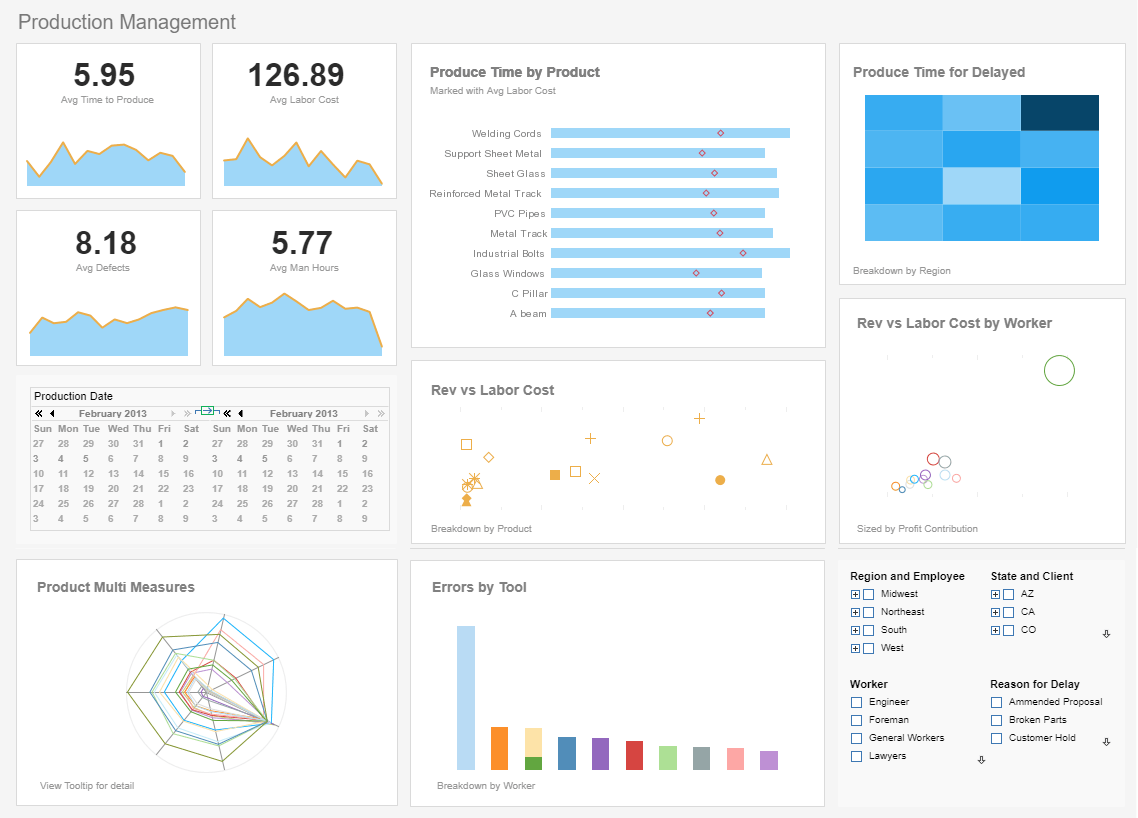Real Example of Proactive Performance Management
This is the continuation of the transcript of a Webinar entitled, "Knowledge Driven Performance Management” hosted by InetSoft. The speaker is Christopher Wren, Principal Consultant at TFI Consulting.
At least in the work that I’ve done with several organizations in terms of how I’ve been linking performance management and knowledge management, is going to be illustrated on this diagram so I’m going to go through it in a little bit of detail.
On the top left hand side of the diagram is a very simple performance management metrics hierarchy. This was actually generated using the performance soft views tool and you can see it very easily. There’s high-level metrics. It drills down to more detailed metrics in a number of different areas until we get down to a point where we have one metric.
In this particular diagram, it has to do with customer complaints, which is marked in red. So this is a traditional way in which metrics might be organized for a particular team or division. As I was mentioning just a second ago, this is an example of performance reporting in the sense that we identified certain metrics.
We established certain criteria for determining whether a metric was red, yellow, or green. We’ve now sat down at our weekly staff meeting, brought up this particular chart,
| #1 Ranking: Read how InetSoft was rated #1 for user adoption in G2's user survey-based index | Read More |
Linking Performance Management and Knowledge Management
And let’s say Jack happens to work on my team and he’s responsible for customer complaints. He’s now gone into the red territory. In the traditional setting, because of the red, I’d sit Jack down and hammer him with questions. Afterwards, he’d explain to me and make promises and hopefully, by the next time we’d meet together, he’d have the problems solved.
In terms of the work we’ve been doing, in linking performance management and knowledge management, picking on Jack, I’d give him more proactive guidance in terms of how to solve these problems. For instance, using TFI Consulting as our organization and Jack as an individual, we’d have a lot of internal knowledge assets. We have methodologies for doing everything under the sun, including things like customer relationship management, customer satisfaction surveys, and managing customer complaints.
One of the important things in our organization is that we have hundreds, literally hundreds, of methodologies that we apply for our clients on solving problems. However, if I’m Jack and I’m faced with this problem, I don’t care about hundreds of methodologies. I only care about those customer satisfaction and resolving customer complaints. So how can I link my performance management system, in this particular metric, with those assets in my methodology that can help Jack fix this problem?
Continuing on, in TFI Consulting, we have, just like many organizations, many different assets that you don’t necessarily think of immediately, but if you think about them, they obviously become applied here. So we have a learning management system, an online computer based training system. In that computer based training system, there are literally thousands of course and I can go in there any day of the week and take any of those courses depending on what my interests are.
 |
View live interactive examples in InetSoft's dashboard and visualization gallery. |
Performance Indicators Become Red
But when Jack’s performance indicators become red because of customer complaints, he doesn’t care about thousands of courses. All he cares about are those specific courses that he might take in the next day or week that could help him and his team improve the situation with customer complaints. In TFI Consulting, we have hundreds of discussion forums that involve consultants from around the world talking on hundreds of different topics. I can even join those discussion forums, and get expert advice from people around the world anytime I want.
But when Jack has faced a problem of customer complaints going red, he doesn’t care about hundreds of discussion forums. He wants to find those discussion forums and the experts that contribute to those discussion forums that know about resolving customer complaints, customer relationship management, and customer satisfaction.
So as part of our solution, we would link that particular performance indicator with those discussion forums that are dealing with this particular topic that can help Jack and his team performance get back on track and in harmony with the rest of the organization. At TFI Consulting we have a worldwide document management system where we manage the working papers and the deliverables from thousands of different engagements. It’s a very valuable asset that we have as an organization.
Jack needs access to it but doesn’t want access to thousands of documents from engagements over the last twenty years. He wants access to those documents that may give him insight into how he can solve this problem, his customer relationship management, and customer complaint problem on a specific engagement.
 |
View a 2-minute demonstration of InetSoft's easy, agile, and robust BI software. |
So in terms of TFI Consulting and the solutions we offer for our clients, this is the approach that we’re taking to provide a more proactive, corporate performance management culture. We’re not only identifying and doing the traditional thing of identifying key performance indicators, but we’re also linking those things to individual compensation plans and incentives and taking it even one step further to allow the individuals to have access to all of the best assets that we have in our organization.
| Previous: Reactive vs Proactive Performance Management |


